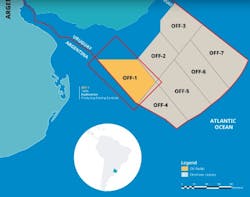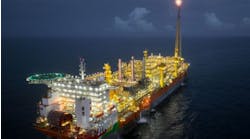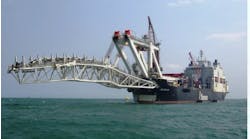Challenger identifies three main prospects in offshore Uruguay acreage
Offshore staff
DOUGLAS, UK – Challenger Energy has released the main findings of a technical assessment of the company’s AREA OFF-1 exploration license offshore Uruguay.
This has defined a prospect inventory of 1-2 BBoe based on 2D seismic reprocessing, managed by Down Under Geophysics in the UK, with three standout structures identified. The play types are consistent with those de-risked following recent successful conjugate margin drilling in the Orange basin off Namibia, across the Atlantic Ocean.
AREA OFF-1 is in the Punta del Este basin, along the Uruguay-Argentina continental margin. This and the Orange basin off southern Namibia and northern South Africa were co-joined prior to continental separation and are thought to have similar geological characteristics in terms of potential source rocks and petroleum systems.
Currently TotalEnergies is drilling up to four appraisal wells in the Orange basin to delineate the extent and scope of last year’s ultra-deepwater Venus discovery.
South of Uruguay, Equinor and Shell plan to spud Argentina’s first ultra-deepwater well (Argerich-1) during the current quarter, 300 km offshore, in 1,500 m of water and to a TD of 4,050 m. According to Challenger, the well will target Cretaceous basin floor sandstones similar to those encountered by the Venus discovery well.
In addition, Equinor, in partnership with YPF, has environmental approvals to acquire 3D seismic across three blocks off Argentina, with Shell and TotalEnergies, along with partners BP and Qatar Energy, also set to acquire 3D seismic on their Argentinian acreage during 2023/2024.
Offshore Namibia, Shell reportedly could to drill up to 10 exploration and appraisal wells in 2023 / 2024. GALP is lining up a well on license PEL83 off Namibia, and Maurel & Prom has indicated a five- well campaign offshore Namibia starting later this year, Challenger said.
The company expects to completed a geotechnical assessment of its Uruguay AREA OFF-1 license by Q3 2023. Aside from reprocessing 2,100 km of legacy 2D seismic, it has completed AVO analysis, geochemistry seabed sampling, and satellite seep and slick imagery reviews.
The three main prospects identified to date are:
- Teru Teru – a Cretaceous turbidite play in 750 m water depth, with a petroleum system and reservoir age analogous to Namibian ultra-deepwater discoveries. The prospect extends across 460 sq km and could hold over 700 MMboe recoverable, with a reservoir depth of 4,300 m.
- Anapero is another Cretaceous turbidite play prospect with similar analogies and water depth, 500 sq km in areal extent, potentially containing over 500 MMboe. The reservoir depth is around 3,800m.
- Lenteja is an Early Cretaceous alluvial fan/stratigraphic trap in 85 m water depth, analogous to proven legacy shelf discoveries in Namibia and South Africa, 425 sq km in areal extent, potentially 500 MMboe recoverable.
Going forward, the company will look to define additional leads and prospects, refine mapping of identified prospects, and seek to further constrain key technical risks.
It also aims to launch a farm-out process following interest in its data-room to help fund new 3D seismic acquisition.
04.26.2023



